The thing I love most about my job is that I get to do it during one of the most transformational times we’ve ever seen in the technological age. I genuinely believe that artificial intelligence (AI) has brought us to an inflection point, and that if we harness its power correctly, it is capable of tackling some of the biggest challenges we face as humanity.
With recent advances in large language models (LLMs) and generative AI, innovation is happening at a mind-boggling pace. It is sparking the next industrial revolution, and I don’t think it’s hyperbole to say that it could even help usher in a new age of abundance. The potential is truly limitless.

Here are just a few of the reasons why I’m so bullish about the future of AI, which I recently shared with SXSW attendees.












